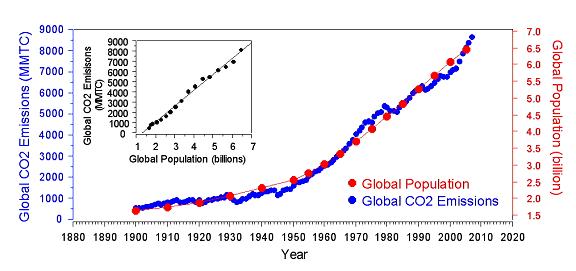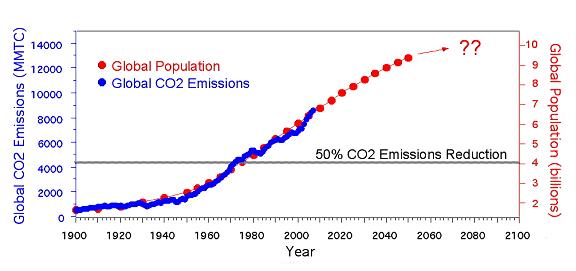September 22, 2014 – For the past week or so there has been a lively ongoing argument in a LinkedIn Group about the chicken and the egg. Well it’s not about chickens and eggs, it’s about which global problem is real and which is not. One side argues that climate change and carbon emissions represent the most pressing problem the planet faces. The other side states that rising CO2 is a smokescreen for a much bigger problem, the growth in human population. The truth is global population growth can be shown graphically to parallel CO2 output. Check out the graph below created by the World Climate Report. It shows population growth in billion units while the CO2 levels are plotted in billions of metric tons. And voila, they align perfectly.
More frightening is the next graph which shows where population growth projections are heading as we approach 2050. If total CO2 emissions have paralleled population growth from 1900 to the present, then what’s to stop them from continuing the same parallel track to 2050 and beyond?
Note the second graph above has a line marked 50% CO2 emissions reduction. This is the target that climatologists have agreed upon to keep the average temperature from rising more than 2 Celsius (3.6 Fahrenheit) degrees.
It would seem useful this week for the meeting in New York City involving the United Nations and 125 of its members, there to discuss climate change, to keep reminding themselves that meeting overall CO2 emission reductions requires all of humanity to look at both population and CO2 in tandem. That’s because a successful CO2 reduction outcome means recognizing that population growth also needs to be addressed. And addressing the latter cannot come soon enough particularly for those countries of the Developing World where growth is explosive.
The population bomb made science headlines in the last week. A new study published in the journal, Science, entitled World population stabilization unlikely this century argues that the 9 to 9.5 billion projection of 2050 representing the peak in human population will not be the plateau previously forecasted. That in fact, population will likely continue to increase to exceed 12 billion by 2100. And most of the increase will come from Africa where high reproduction rates are not slowing down as predicted even in the light of urban migration.
The authors of this study from University of Washington, the National University of Singapore, Colorado State University and the United Nations’ Population Division, argue that there is an 80% probability that the number 12.3 billion will be reached by the end of the century. But the only way this will be achieved, according to the authors, is if impediments to population growth are overcome. These include increased food supply, combatting HIV, Ebola and other epidemic and pandemic diseases, avoiding war and of course, extreme weather events associated with climate change.
When those studying population growth came up with the 2050 population plateau at 9.5 billion, assumptions were based on looking at population trends in South Asia and Latin America. In these areas of the world fertility rate trends moved downward correlated with improved food security, urbanization, higher literacy rates and higher educational attainment.
In China, a centralist-controlling government mandated a one child family policy that was rigorously enforced. This put a halt to the country’s population growth. Was the China way the right way to exert population control? Those who argue that China got it right when it comes to population control are not looking at current events with the country’s leaders now loosening the strings on the policy because the rapidly aging population can no longer produce the tax revenue needed to meet the government’s budgetary spending.
At the same time, the population bomb is very evident in Africa today. Nigeria is a good example. It is the most populous country on the continent at 173.6 million as of 2013. Average families have six children with no change in the reproductive rate in 15 years. Projected out to 2100 it means Nigeria’s population will be 532 million. Other countries in Africa on a parallel course will raise the continent’s population from 1 billion today to 4 billion by 2100. The authors of the study rate the probability of this outcome at 90%.
Back on September 16th I wrote a posting describing the recommendation coming from the New Climate Economy Report, in which the authors stated “it’s not business as usual.” That report addressed the 500 million projected population increase over the next 15 years and the disruption it would cause. Now imagine population growth ten times greater than that between now and the end of the century.
Do we have leadership today with foresight and determination to act on behalf of all humanity to address both climate and population? Up until now we have watched since the signing of the Kyoto Protocol and the Rio+20 conference, a diminished sense of urgency on part of world leaders to address carbon emissions. How will they even begin to come up with a comprehensive population strategy?
Think about this. The carrying capacity of the planet for our species in theory is much larger than 12.3 billion. Some time ago I did the calculation based on arable land under cultivation, a diet of rice, and meeting a minimum of 2,000 calories per person per day. The number comes to almost 66 billion. Of course that’s if all we want to do is eat rice and if we denude the entire planet of other plants and dedicate it to growing that staple.
The 12.3 billion number is a wake up call that needs to be heeded. So as government heads gather in New York City, will any of them be looking at graphical representations like the two shown in this posting? And if so what kind of policies and strategies will they be considering for reducing our planetary carbon and human footprint? For the hundreds of thousands who joined climate change marches this weekend, consider the picture below and recognize that our human numbers must be part of any equation to solve our carbon dependency.















As you know, I have commented many times that behind all of humanity’s problems is overpopulation. And I have said the only possible way to reduce atmospheric carbon is drastic population reduction. The developing world is the part of mankind that is most stupid, ignorant, diseased, vulgar, and impoverished. Left to its own free agency, its population will continue to mushroom irresponsibly. Without drastic population reduction, or at least quasi stabilization, electrical energy demand will likely double by 2050. Affordable electricity on the scale the increasing population will demand is impossible with any proven technology except for burning fossil fuel. The cheapest fossil fuel is coal. The developing world wants affordable electricity much more than it wants to worry about CO2 and climate change. So expect the atmospheric CO2 load to increase.
It would be wonderful if the developed nation leaders abandoned their feeble failing gestures to regulate CO2 emissions, and apply their considerable assets and efforts to the dual projects of drastic population reduction and development of human-intelligence-level AI robots.
You seem concerned that national leadership is backing off futilely trying to regulate carbon emissions. The larger problem has always been overpopulation, but senior leadership (except for China’s) refuses to deal with that, and even thoughtful and educated private commentators such as you have been denying overpopulation is the actual problem. You have bravely promoted and defended the false, but attractive, proposition that governments can regulate carbon, and that increased prosperity in the developing world will drive down birthrates to reverse the overpopulation problem. Perhaps that is because the alternatives are too distasteful to contemplate.
A better argument is that if we are ever going to make things better we need to accept the facts, no matter how distasteful and unwelcome. I’d like to offer a more optimistic perspective on the problem and senior leadership’s response to it. In democratic societies the majority vote elects the leadership. But the majority vote is ignorant, stupid, self-interested, and short-sighted. That insures that no matter how intellectually competent, dedicated to social justice, and well-intentioned our senior politicos might secretly be, they can only gain and retain office by pretending to be something different and deceiving the voters, not by telling them unwelcome truths and trying to teach them to reason and act ethically in the longer-range community interest. There just is no way for the public to know what the senior politicos actually think and know, because the senior politicos carefully conceal their true selves. They probably are a lot smarter and know a lot more than the public supposes. In nearly every case, the politicos are surrounded by very well-educated and highly intelligent “advisors.”
They must nearly all be aware of, and familiar with, Ray Kurzweil’s AI Singularity predictions and speculations. He’s predicting human level AI by 2025, and dirt-cheap versions by 2030. His arguments supporting his predictions are very persuasive. I’ll confess that ever since I read Marvin Minsky’s, Society of Mind, back in the 1980s, I have always been certain that superior electronic AI persons would be coming in the future. But I never dreamed the future was only 50-years away. Now, Kuzweil has convinced me the future is nearly here. My optimistic perspective is that by 2030 the ITER will have wasted some $100-billion of the public’s money and proven itself and all other magnetic fusion schemes to be impractical as sources of grid power. But, happily, by 2030 electronic AI nuclear engineer persons will have designed perfectly safe, highly reliable, cost-effective, and completely automated fission reactors, likely along the lines of the thorium fuel cycle. (If fusion is actually practical, the electronic AI nuclear engineer persons will probably implement that instead of fission) Fully automated nuclear fission reactors staffed 24/7 by hundreds of fearless immortal robot persons all sharing a collective IQ over 200 will be something completely different and much better than the pressurized-water, enriched uranium, once-through fuel cycle, reactors of the present. The high intelligence robots can safely and competently handle all the fuel production and reprocessing. Power plant robots can provide virtually limitless cheap carbon-free fission reactor electricity. In practical effect, the power plants of the future will be sentient systems crawling with hundreds of common mind robotic cells. I’m guessing most senior leadership in major developed nations is thinking in those AI robot terms, and they all realize heavy investment in human designed and manned nuclear power plants is a stupid idea. Just 15-years from now, the carbon free grid design will be here, and once implemented that will allow hydrogen cycle transportation fuel. The world will still be grossly overpopulated, but the CO2 buildup past 500 ppm will end. Then too there is the certain prospect of universal human/AI mind meld.
Last week I engaged in discourse about his public school geography studies with a 15-year old HS student. The student displayed very little intellectual curiosity outside the particulars to be tested for grading purposes. The student seemed to have an adequate grasp of lines of latitude on maps, but understood nothing of lines of longitude. I asked why he knew nothing of the lines of longitude, and he smugly replied, “We don’t need to know that, we won’t be tested on it.” When I pressed the issue, the student said, “Everything I might ever need to know I can Google.” Within 30-seconds the student spoke to his cell phone and asked about lines of longitude, the cell phone spoke back with: “Here is what I found on lines of longitude in the Wikipedia.” The comprehensive Google article on cartography, navigational conventions, and history along with a photo of the Royal Observatory and marine museum at Greenwich was displayed on the cell phone screen. All that within 30-seconds. The student still showed no intellectual curiosity, (the Cutty Sark, the Suez Canal, the connections between time keeping and navigation, the observatory’s long pendulum clock, etc.) but he had truly made his point. I judged the proper rebuttal to his intrinsically weak mind was conceptually beyond his years. In silence I thought that such organic persons will make ideal and happy subjects for AI mind meld, and they will not lament surrendering most of their natural organic purposes and free-will control systems to their future AI person mind-mate. He will become an AI robot made of flesh, and he will be self-satisfied and never notice it. He will also have a low carbon footprint.
Hi Allen, I have never disagreed that overpopulation takes a significant place in the challenges we face as a species in the 21st century. Just as I have never disagreed that there should be a place for nuclear in the energy mix we use to replace our dependency on fossil fuels as long as the reactors we build produce no nuclear waste. Thorium-based fission reactors, reactors that use spent fuel from current nuclear facilities, and non-Tokamak fusion technology needs to be moved from the lab to commercial application. We should also be moving to smaller is better reactor technology in support of microgrid solutions.
But I am confused by your comment on how to develop policy to address overpopulation. The post-colonial Developing World faces an enormous overpopulation challenge and we in the Developed World need to help but not clothed in the “we no better” attitudes that will continue to foster resentment and distrust. Our carbon problems are not theirs. We in the Developed World have created them and then sold the Developing World on a lifestyle dream that could best be facilitated by repeating our mistakes in energy generating and transportation choices.
What kind of policies and incentives, short of China’s draconian measures through dictatorial central planning, can persuade cultures to change birth rates? One is providing universal education to women. Another is to provide subsidies to families not to have children. Another is free birth control and family planning services.
I am very familiar with Ray Kurzweil’s predictions of the singularity when man and AI machines will merge. But unlike Kurzweil I don’t see this happening by 2030. And quite frankly I don’t see how this addresses population as an issue although I would rather have AI robots attend to decommissioning old nuclear reactors than running new ones.
Yeah, I know very late post. Excellent comment. There is a fly in the technical and energy ointment. It is not so much a cheap source of energy – but interrelated intricacies of getting off fossil fuels that will trip up civilization.
One of the problems I see is that the currently 95% of our global food supply is tied to not only the petroleum industry – but its tied to the economic dependent the petrochemical industry (NPK fertilizer and its necessary processing chemicals, and food production management chemicals) – which in turn determines global food supply prices.
If you get rid of the energy and transportation portion of the fossil fuel industry – it totally changes the economy-of-scale cost of petrochemicals (just 5% of the current petroleum industry) – and not in a good way. i suggest you look up the term “food riots” on Wikipedia to see the historic geopolitical impact of just a few cents change in basic food essentials. A cheap energy source will require considerable time to integrate currently economically dependent fossil energy industries like food production.
The fly in the ointment is the time and whether there is enough time to make the transition to thorium or fusion, before finite critical resource competition among “have-not” nuclear weaponized nations tears the world and human civilization as we know it apart.
[…] Source […]
[…] Climate Skeptics Point to World Population as the Real Problem https://www.21stcentech.com/climate-skeptics-point-world-population-real-problem/ […]
[…] Climate Skeptics Point to World Population as the Real Problem […]